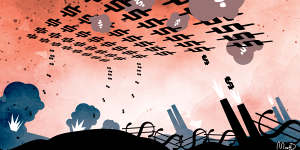This is just one of the many fascinating things you learn from a new book,The Shortest History of Economics,written by Dr Andrew Leigh,former economics professor turned minister in the Albanese government. (The book’s name is misleading. It’s really the shortest account of the part the economy has played in the world’s history. Well worth a read.)

Matt Davidson
Leigh says the first industrial-scale war following the Industrial Revolution was America’s Civil War during the first half of the 1860s.
“With the use of mass-produced weapons,railroads,steamships and telegraphs,the Civil War was industrial in its scale,and in its carnage,” he says. More than 600,000 combatants – one in five soldiers – lost their lives.
A striking thing about that war was the imbalance of resources between the two sides,strong support for the saying that God is usually on the side with the bigger battalions.
At the outset,the North had a population of 21 million – more than twice the South’s. The South was primarily an agricultural economy,with the North producing 90 per cent of the country’s manufactured goods,including 97 per cent of its firearms.
What’s surprising is that the South held out as long as it did. The war was prolonged by the North’s poor military tactics.
From an economic perspective,wars are often financed by printing money,with ultimate inflationary consequences. The South used this to fund 60 per cent of its costs,whereas the North needed only 13 per cent.
To economists,a significant effect of World War I was that it brought a hasty end to the world’s first experience of globalisation,with greatly increased trade and migration between Europe and the “new world”,fostered by the advent of steel-hulled steamships and the telegraph,and the absence of boring things like passports and visas.
Not until after the Great Depression and World War II did the barriers keeping countries apart begin falling back,thanks to advances in air travel,shipping,containerisation and telecommunications,plus reductions in import protection and banking regulations.
Today,many people believe that greater trade,tourism and other economic contact between countries reduce the likelihood of war. I think there’s truth to this,but the strong commercial ties between the combatants in World War I didn’t stop it happening.
Did you know that,at the outbreak of war in 1914,most of Germany’s shipping trade was insured by Lloyd’s of London?
The Allied powers (Britain,France,Russia and their allies) had far more resources than the Central powers (the German Empire,the Austro-Hungarian Empire and their allies). The Allied powers had five times the population,11 times the territory and three times the income,according to Leigh.
That the conflict took four years and claimed about 20 million lives reflects the ineptitude of the generals and the intransigence of the political leaders,he says. But the side with the larger economic base won.
Moving on to World War II,which started in 1939 and ran for six years,its outcome,too,could have been predicted from the economic fundamentals.
Compared with the Axis powers (Germany,Italy,Japan and their allies),the Allied powers (Britain,France and their allies) had more than twice as many people,more than seven times as much territory,and a combined income that was 40 per cent higher,Leigh tells us.

The second war saw squadrons of bombers devastating cities with incendiary – and ultimately atomic – bombs.Internet
Germany did well at first,thanks to the skill of its generals,such as Erwin Rommel,but the war proved primarily a contest of industrial production,Leigh says,and the Allied powers had more resources at their disposal.
This was true even midway through the war because,although Germany had annexed much of Europe,the United States and the Soviet Union had joined the conflict on the side of the Allies. In 1942,the Allied powers still retained a decisive advantage in people,territory and income,he says.
Consider aircraft carriers. Although Japan fully understood their great strategic value,the Allies built nine-tenths of the carriers produced during the war.
The combatant nations differed in how much of their economies they devoted to the war effort. Italy never devoted more than a quarter of its gross domestic product to the war,whereas,at its peak,Japan was devoting more than three-quarters. Britain and Russia managed to deliver more than half their national output to the war,while the US devoted two-fifths.
Together,this gave the Allies a substantial advantage. They produced at least twice as many rifles,tanks,aircraft,mortars and warships. According to Leigh,the Axis powers were literally outgunned.
The overall damage to economies done by World War II was more devastating than in World War I,largely because the technology of killing had advanced so much in the intervening years.
In the air,the first war’s biplanes and zeppelins played a relatively minor role,whereas the second war saw squadrons of bombers devastating cities with incendiary – and ultimately atomic – bombs.
All up,World War II claimed three times as many lives as World War I had done.
But let’s finish on a more positive note. Leigh says the peace that followed World War II was more enduring,partly because countries learnt the lessons of the previous conflict. Through the Marshall Plan,the US provided $US13 billion to Western Europe,equivalent to about 3 per cent of the region’s annual economic output.
In Germany and Japan,the occupying powers put great emphasis on restoration,with the result that both became major industrial powers within a generation.
And economists,including Keynes,played a central role in building international economic institutions – including the Bretton Woods system of fixed exchange rates,the International Monetary Fund,the World Bank and the forerunner to the World Trade Organisation – that would sustain peace.
Ross Gittins is the economics editor.
Ross Gittins unpacks the economy in an exclusive subscriber-only newsletter..